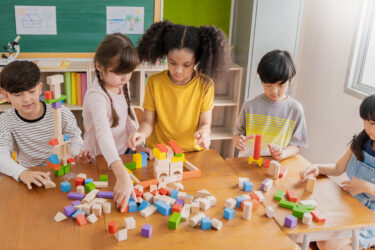If kindergarten is the new first grade … will your child be ready next fall?
Now that the new school year has begun, the looming question for many parents with preschoolers is: What do I need to do? And, will MY child be ready compared to the other children who will be in his class next year?
Most often, the question of kindergarten readiness arises when a child turns 5 within a few months of the cut-off dates. Parents of children born as far ahead as May, particularly parents of boys, become concerned with whether their child will be ready to begin classroom work. The decision is not one to be taken lightly. A year is a long time to take out of a child’s life, and the decision rests solely with the parents.
Schools today make kindergarten an integral part of the elementary school’s curriculum, and the focus has shifted from social to academic.
WHERE IS HE AT?
Readiness for kindergarten involves the child in the school setting, so when considering whether or not your child will meet kindergarten success based upon his abilities, you must take into account both the program and the teacher’s expectations of your child.
“Start preparing your child from day one,” suggests Jennifer Jensen, head of the lower school at Cincinnati Country Day school. “Similar to sending our children off to college, it takes years to instill all that they need to be successful on their own,” she adds.
Kindergarten teachers expect children to be able to function within a cooperative learning environment where they work both independently and as a member of small and large groups.
“Perseverance, self-regulation and flexibility are all great skills to have prior to entering kindergarten,” says Jensen.
“With these skills, a child can actively explore new situations, engage in problem solving and expand his thinking,” she adds.
Children should be able to attend to and finish a task, listen to a story in a group, follow two or three oral directions, take turns, and share and care for their belongings. They are also expected to follow the rules, respect the property of others and work within the time and space constraints of the school program.
Teachers expect children to develop certain physical skills before they enter kindergarten, too. In order to write letters and to make attempts at written and drawn expression, children are expected to enter kindergarten having already mastered fine motor skills requiring eye-hand coordination, such as using pencils, crayons or scissors. It is a definite plus for children to be able to master belts, buttons, zippers and shoelaces.
Children are also expected to possess both visual and auditory awareness of sounds and objects. These skills will be needed to learn the sounds of letters and the names and quantities of numerals. Children should grasp the concepts of “same and different” so they can sort objects into groups whose members are alike in some way. Usually, the kindergarten teacher expects students to recognize and name colors, shapes, sizes and a child’s own name (although these concepts are often part of the curriculum early in the school year).
Most 5-year-olds can express themselves fluently with a variety of words and can understand an even larger variety of words used in conversations and stories. Children who have been read to from an early age are usually interested in the printed word and how it is used to express ideas; a concept of story and story structure; and an understanding of the relationship between oral and written language.
Some sense of numbers is also ideal, like counting and being able to recognize numbers from 0 to 10. A further issue is what the teachers and school system expect the child to accomplish by the end of kindergarten. It’s helpful if children can recognize some words. They should be able to sound out simple, three-letter words with short vowels and read short sentences like, ‘I like you.’ If you read a lot to your child at home, it helps tremendously with early readers.
As expectations become more academic and assessments more formal, pressure increases to retain children who do not meet expectations. The assumption is that children who have not achieved a minimum level of cognitive and academic skills prior to first grade will benefit from another year of kindergarten. While that may be true for some, it is not true for others. Developmentally appropriate programs assume that children vary upon entrance; that all children progress during the program at their own rates and in their own manner; and that children will continue to vary at the end of the program.
HOW TO GET INVOLVED
You can help your child learn to recognize the letters of the alphabet — the beginning of the process that leads to reading — and to also help him learn the sounds the letters make. If a child knows his alphabet and the sounds the letters make upon entering kindergarten, he is on the path to reading.
Additional skills you can help your child acquire in the year leading up to kindergarten include:
• Count from one to 10 or higher
• Identify colors and shapes
• Name parts of the body
• Distinguish between left and right
• Demonstrate an ability for small motor skills like holding a pencil or a pair of scissors correctly
• Demonstrate an ability for following directions, including multiple-step directions
• Show an understanding of stories
• Demonstrate clarity of speech
• Demonstrate an increasing vocabulary
• Demonstrate the ability to tell a story in sequence
READY, SET, GO!
Readiness for kindergarten depends on your child’s development of social, perceptual, motor and language skills expected by the teacher. It also depends on the curriculum’s degree of structure, the behavior required by the instructional program and expectations of what is to be achieved by the end of the program.
To help you in preparing your child for kindergarten and in assessing whether your child will be ready to attend, most schools provide booklets on readiness.
And while checklists are always useful, you know your child best — if come next summer you feel he’s ready, then it looks like he’ll be heading to kindergarten!
READINESS KEYSTONES
Experts agree that a child’s development needs to be evaluated in several areas.
The following is a guideline that includes a range of social, academic and developmental factors to consider when deciding if your child is ready to enter school:
Enthusiasm toward learning. Is he eager to explore and discover? Is he comfortable asking questions? Does he persist even when a task is difficult?
Does he communicate his needs? Express his feelings appropriately?
Ability to listen. Can he follow simple instructions? Is he able to listen to an entire story without interrupting?
Desire to be independent. Will he separate from you for the school day? Is he starting to take responsibility for his personal belongings? Can he follow simple two-step tasks? Can he use the bathroom by himself?
Ability to interact with children and adults. Is he able to share, compromise, take turns and problem-solve?
Strong fine-motor skills. Is he able to hold and use a pencil? Cut with scissors? Can he write his name?
Basic letter and number awareness. Can he recite the alphabet and recognize some letters? Can he count to 10 and identify numbers one to five?





